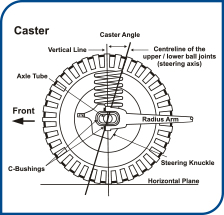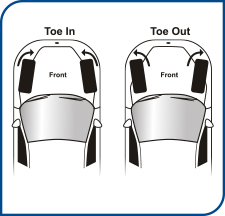A correct wheel alignment can save you plenty on the cost of tyres. Badly-aligned suspensions wear tyres out rapidly and are also unsafe, as they affect your car’s handling.
Camber and castor angles which are out cause uneven wear on your tyres and your car is unable to track true. Ideally you should have your wheels aligned every time you get a new pair of tyres fitted, followed by checks at regular intervals. (Approx. every 10,000km’s)
Camber is the measurement in degrees of the angle of the tyre from vertical when seen from the front or rear. A tyre tilting out at the top has positive camber, inward tilt is negative camber. Positive camber is normal in a stationary road car, the tyre becomes approximately vertical once the vehicle is in motion.
The relationship between the steering axis and true vertical is the castor. Zero castor is when the steering axis is vertical. When the steering axis is tilted backwards (by far the most common design) it has a positive castor. Unequal castor from side to side causes steering pull to the side which has the least amount of positive castor.
Toe in is the difference in distance between the front of the wheels and the rear of the wheels. Most vehicles have some inward pointing of the wheels when stationary, the wheels become approximately parallel when the vehicle is in motion.



